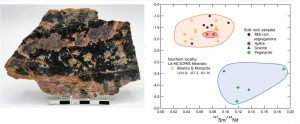Petrogenesis of magmatic REE mineral occurrences near Jamestown, Colorado (U.S.A.)
| REVIEWS AND HIGHLIGHTS | QUANTUM SCIENCE | MOLECULAR AND SOFT-MATTER | ULTRAFAST NANO-OPTICS AND NANOPHOTONICS | MINERALOGY AND GEOCHEMISTRY |
|---|
Charles R. Stern, Shea Burnham, Andrew Kylander-Clark, Julien Allaz, and Markus B. Raschke
Mineralium Deposita 59, 1737 (2024)
DOI PDF
 Two magmatic REE-rich occurrences, located near Jamestown, Colorado, and hosted in the Precambrian Longs Peak granite batholith, exhibit unusual textures that suggest formation by fluoride-silicate melt immiscibility. Both contain small (<2 mm diameter) globular F-, P-, and REE-rich segregations of fluorite and monazite-(Ce). In addition, the northern of the two localities preserves evidence of a second melt immiscibility event in the form of larger (up to several cm diameter) aplite-hosted globular segregations of fluorite and the REE minerals allanite-(Ce), monazite-(Ce), fluorbritholite-(Ce), törnebohmite-(Ce), and cerite-(Ce). The southern of the two localities lacks these cm-scale globular textures, but instead contains much larger aggregates of these same REE minerals, with up to >57 wt. % ΣREE2O3, yet no fluorite, as well as large aggregates of allanite-(Ce) and quartz, and an amphibole-bearing REE-rich rock containing allanite-(Ce), other REE minerals, quartz and minor apatite. A new Nd-Sm laser ablation age of 1.422(24) Ga on monazite-(Ce) and allanite-(Ce) from the southern locality implies the same age of formation of 1.420(25) Ga as for the northern locality, with equally similar initial εNd1.42Ga values of these REE minerals. A newly discovered third locality, containing primarily allanite-(Ce), minor monazite-(Ce), and thorite, without fluorite, extends the number, spatial distribution and total volume of these mineralogically unusual magmatic REE occurrences. We suggest that the REE were concentrated in these three localities by multiple stages of fluoride-silicate melt immiscibility. For the southern locality, slower cooling of a possibly larger magma volume, or in a deeper environment, allowed greater aggregation of the immiscibly separated REE-rich phases, as well as loss of the volatile element F, resulting in a greater availability of Ca accommodated by the crystallization of amphibole and minor apatite.
Two magmatic REE-rich occurrences, located near Jamestown, Colorado, and hosted in the Precambrian Longs Peak granite batholith, exhibit unusual textures that suggest formation by fluoride-silicate melt immiscibility. Both contain small (<2 mm diameter) globular F-, P-, and REE-rich segregations of fluorite and monazite-(Ce). In addition, the northern of the two localities preserves evidence of a second melt immiscibility event in the form of larger (up to several cm diameter) aplite-hosted globular segregations of fluorite and the REE minerals allanite-(Ce), monazite-(Ce), fluorbritholite-(Ce), törnebohmite-(Ce), and cerite-(Ce). The southern of the two localities lacks these cm-scale globular textures, but instead contains much larger aggregates of these same REE minerals, with up to >57 wt. % ΣREE2O3, yet no fluorite, as well as large aggregates of allanite-(Ce) and quartz, and an amphibole-bearing REE-rich rock containing allanite-(Ce), other REE minerals, quartz and minor apatite. A new Nd-Sm laser ablation age of 1.422(24) Ga on monazite-(Ce) and allanite-(Ce) from the southern locality implies the same age of formation of 1.420(25) Ga as for the northern locality, with equally similar initial εNd1.42Ga values of these REE minerals. A newly discovered third locality, containing primarily allanite-(Ce), minor monazite-(Ce), and thorite, without fluorite, extends the number, spatial distribution and total volume of these mineralogically unusual magmatic REE occurrences. We suggest that the REE were concentrated in these three localities by multiple stages of fluoride-silicate melt immiscibility. For the southern locality, slower cooling of a possibly larger magma volume, or in a deeper environment, allowed greater aggregation of the immiscibly separated REE-rich phases, as well as loss of the volatile element F, resulting in a greater availability of Ca accommodated by the crystallization of amphibole and minor apatite.
